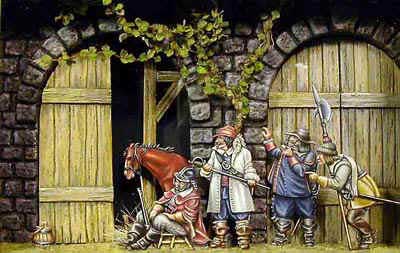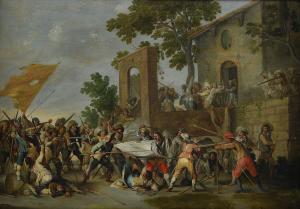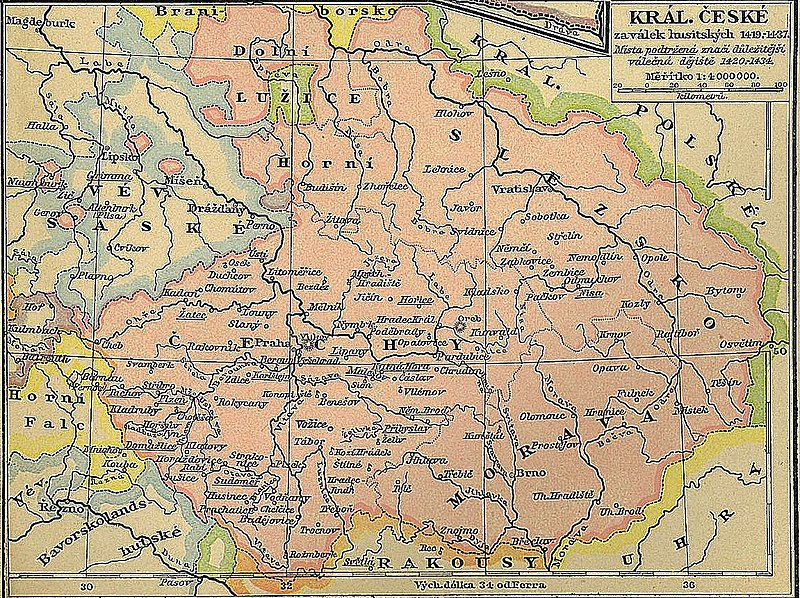
[edit] BiographyHe was born in a painting family in Antwerp as the son of the painter Jan de Wael I (1558–1633) and Gertrude de Jode, making him a cousin of Pieter de Jode II.
 His brother, Lucas de Wael (1591–1661) accompanied him on his trip to Italy where they
His brother, Lucas de Wael (1591–1661) accompanied him on his trip to Italy where they  settled in Genua.[1] When Anthony van Dyck visited Genua he stayed with the brothers.
settled in Genua.[1] When Anthony van Dyck visited Genua he stayed with the brothers.
Cornelis was known mainly for his etchings, but he also has a reputation for painting landscapes.
 According to Houbraken he specialized in battle scenes and worked for Philip III of Spain and Philippe-Charles, 3rd Count of Arenberg. One of his pupils was the Flemish painter Giovanni Hovart.
According to Houbraken he specialized in battle scenes and worked for Philip III of Spain and Philippe-Charles, 3rd Count of Arenberg. One of his pupils was the Flemish painter Giovanni Hovart.
For Wargamers Military Historians and Collectors of Model and Toy SoldiersThe Thirty Years' War (1618–1648) was fought primarily in what is now Germany, and at various points involved most countries in Europe.

The origins of the conflict and goals of the participants were complex, and no single cause can accurately be described as the main reason for the fighting. Initially, the war was fought  largely as a religious conflict between Protestants and Catholics in the Holy Roman Empire, although disputes over the internal politics and balance of power within the Empire played a significant part. Gradually, the war developed into a more general conflict involving most of the European powers. In this general phase, the war became more a continuation of the
largely as a religious conflict between Protestants and Catholics in the Holy Roman Empire, although disputes over the internal politics and balance of power within the Empire played a significant part. Gradually, the war developed into a more general conflict involving most of the European powers. In this general phase, the war became more a continuation of theBPyimQcI-g~~60_12.JPG) Bourbon–Habsburg rivalry for European political pre-eminence, and in turn led to further warfare between France and the Habsburg powers, and less specifically about religion.
Bourbon–Habsburg rivalry for European political pre-eminence, and in turn led to further warfare between France and the Habsburg powers, and less specifically about religion.
A major impact of the Thirty Years' War was the extensive destruction of entire regions, denuded by the foraging armies (bellum se ipsum alet). Episodes of famine and disease significantly decreased the populace of the German states andBohemia , the Low Countries and Italy, while bankrupting most of the combatant powers. While the regiments within each army were not strictly mercenary in that they were not guns for hire that changed sides from battle to battle, the individual soldiers that made up the regiments for the most part probably were. The problem of discipline was made more difficult still by the ad hoc nature of 17th-century military financing. Armies were expected to be largely self-funding from loot taken or tribute extorted from the settlements where they operated.
, the Low Countries and Italy, while bankrupting most of the combatant powers. While the regiments within each army were not strictly mercenary in that they were not guns for hire that changed sides from battle to battle, the individual soldiers that made up the regiments for the most part probably were. The problem of discipline was made more difficult still by the ad hoc nature of 17th-century military financing. Armies were expected to be largely self-funding from loot taken or tribute extorted from the settlements where they operated.rBPyiv,U8m!~~60_12.JPG) This encouraged a form of lawlessness that imposed often severe hardship on inhabitants of the occupied territory. Some of the quarrels that provoked the war went unresolved for a much longer time. The Thirty Years' War was ended with the treaties ofOsnabrück
This encouraged a form of lawlessness that imposed often severe hardship on inhabitants of the occupied territory. Some of the quarrels that provoked the war went unresolved for a much longer time. The Thirty Years' War was ended with the treaties ofOsnabrück and Münster, part of the wider Peace of Westphalia.
and Münster, part of the wider Peace of Westphalia.
 , the Low Countries and Italy, while bankrupting most of the combatant powers. While the regiments within each army were not strictly mercenary in that they were not guns for hire that changed sides from battle to battle, the individual soldiers that made up the regiments for the most part probably were. The problem of discipline was made more difficult still by the ad hoc nature of 17th-century military financing. Armies were expected to be largely self-funding from loot taken or tribute extorted from the settlements where they operated.
, the Low Countries and Italy, while bankrupting most of the combatant powers. While the regiments within each army were not strictly mercenary in that they were not guns for hire that changed sides from battle to battle, the individual soldiers that made up the regiments for the most part probably were. The problem of discipline was made more difficult still by the ad hoc nature of 17th-century military financing. Armies were expected to be largely self-funding from loot taken or tribute extorted from the settlements where they operated. and Münster, part of the wider Peace of Westphalia.
and Münster, part of the wider Peace of Westphalia.
No comments:
Post a Comment